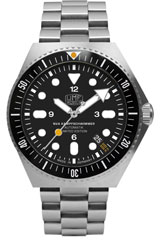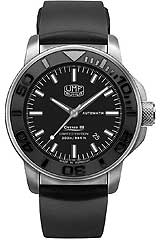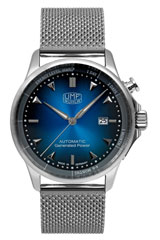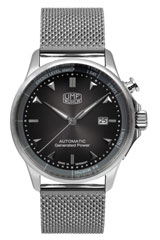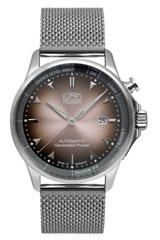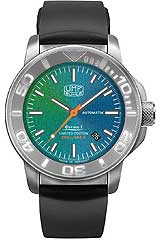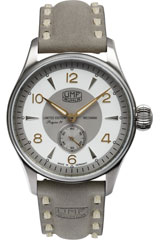Selection:
UMF Ruhla Watches
UMF Ruhla Watches - A legend lives
on Watches from Uhrenwerken-Ruhla GmbH have a very long tradition dating back to 1862. In 1963, the Ruhla electric, the first electric wristwatch in the GDR, was presented at the Leipzig Trade Fair as an in-house development. The most successful model of this period was the calibre 25. Wristwatches with this calibre were built from 1963 to 1991. On 1 March 1967, the watch factories in Ruhla, Glashütte and Weimar merged to form the VEB Uhrenkombinat Ruhla. 1989 After the fall of the Berlin Wall, the state-owned company was privatized by the Treuhandanstalt. Today, Uhrenwerken-Ruhla GmbH manufactures the watch brands Iron Annie, Zeppelin, UMF.
Uhren- und Maschinenfabrik Ruhla - Watches Made in Germany
According to tradition, the origin of the UMF watch factory dates back to 1862. At the end of the 1880s, the company specialized in its core business of watches, especially robust yet reliable pocket watches, with the Ruhlaer pocket watch of 1892. By 1897, 4,000 units per day were already being produced, and a more advanced pocket watch was offered from 1901 onwards. At the same time, the development of special machines and tools for the production of watches, movements, dials, hands began. The company continuously developed and built its own mechanical movement calibers. All in one factory.
After the occupation of Ruhla on 8 April 1945 by US troops (Allies), work was first stopped and then the entire workforce was dismissed. Production was resumed in the first half of July 1945 and by 1949 the previous highest production volume of 1938 could even be surpassed. On May 1, 1952, the company was nationalized by decision of the government of the USSR. This is how the state-owned company VEB Uhren- und Maschinenfabrik Ruhla came into being. In the meantime, the watch and machine factory (dial signet: UMF), which has now been running for several years, has focused on large-scale production, also due to the immense demand for watches for its own population and exports. In 1953, the UMF 69 alarm clock was put into production and thus built for a total of 38 years with the further development as UMR 67. In 1954/55, UMF presented the 15-piece Diva ladies' wristwatch to the public. It was the caliber (UMF Model 3).
On April 30, 1958, the first German jet airliner was introduced. The cabin clock of this aircraft comes from Ruhla. UMF Mod. 37. With an operating voltage of 27 volts. Later, other commercial aircraft were also equipped with these popular and reliable on-board clocks. In 1963, the Ruhla electric, the first electric wristwatch in the GDR, was presented at the Leipzig Trade Fair as an in-house development. The most successful model of this period was the calibre 25. Wristwatches with this calibre were built from 1963 to 1991. At that time, about 30,000 movements were produced daily. In Germany and Europe, the UMF watch factory became one of the largest producers of watches.
Thus, on September 25, 1962, the 100th anniversary of the watch and machine factory was celebrated. Deserving employees will receive a copy of the UMF special edition to mark the company's 100th anniversary. On 1 March 1967, the watch factories in Ruhla, Glashütte and Weimar merged to form the VEB Uhrenkombinat Ruhla. The Ruhla watch combine, whose general director was the former plant manager of the UMF, Heinz Wedler. 1989 After the fall of the Berlin Wall, the state-owned enterprise was broken up into several parts by the Treuhandanstalt and privatized.
The VEB Uhrenwerk Ruhla first became the company Uhrenwerke Ruhla GmbH, then about 40 new companies were created from this or through the founding of a new company. After 1990, 90% of the old factory and production buildings were demolished. One of the well-known industrial monuments and administrative buildings from the great clock era of 1929 has been largely preserved. Then, as now, it also served as a production site for watches in Ruhla. On the ground floor there is an important watch museum on a good 200 square meters, which shows the contemporary history and exhibits of the watch brands from Ruhla.
The six-storey reinforced concrete skeleton building with clinker cladding in the Bauhaus style was built in 1929 according to designs by the architectural firm Schreiter & Schlag. Today, Uhrenwerken-Ruhla GmbH manufactures the watch brands Iron Annie, Zeppelin, UMF. In addition, watches for third-party brands are also assembled there. The building is one of the few contemporary witnesses of the German watch industry in Ruhla, which has followed its intended purpose to this day. A legend lives on!
Choose your preferred payment
You can choose the following payments from our shop: PayPal, credit card and prepayment. For more information visit payment methods & FAQ More payments: prepayment with 3% off for wristwatches
INFORMATION
Last update 2025-02-21 14:47:10



